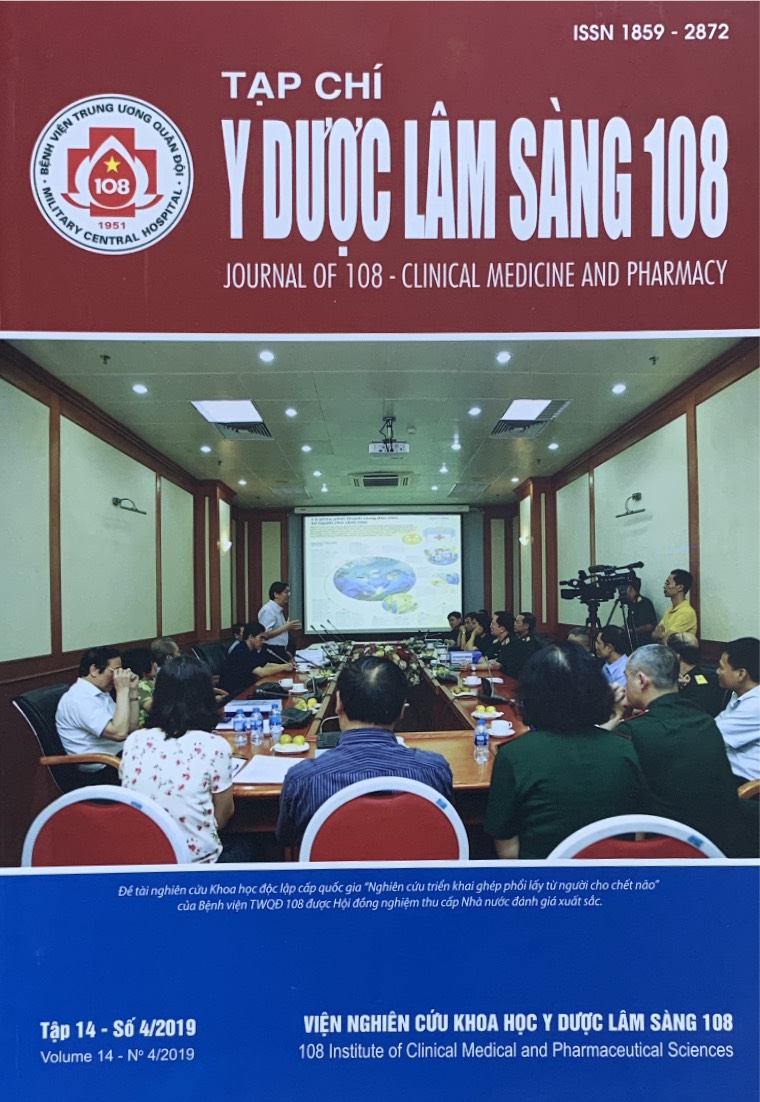Assessment of left ventricular dyssynchrony by GSPECT myocardial perfusion imaging in post myocardial infarction patients
Main Article Content
Keywords
Abstract
Objective: To evaluate left ventricular synchrony parameters using gated myocardial perfusion single photon emission computed tomography (GSPECT) in post myocardial infarction (MI) patients. Subject and method: A cross-sectional study was conducted on 34 subjects without cardiovascular disease and 104 post-MI patients. Result: Left ventricular dyssynchrony parameters including PSD and HBW were 48.7 ± 19.49 and 154.95 ± 71.97 in post-MI group compared to 17.5 ± 7.24 and 53.9 ± 15.14 respectively in the control group, respectively (p<0.01). 77% and 81% of post-MI patients had increased PSD and HBW with left ventricular dyssynchrony. PSD and HBW has increased significantly in post-MI patients with NYHA III-V, low EF compared to NYHA I-II patient group without left ventricular dysfunction. Conclusion: Left ventricular dyssynchrony parameters were commonly detected by GSPECT in post-MI patients. PSD and HBW increased significantly in post-MI patients and were related with NYHA and left ventricular dysfunction.
Article Details
References
2. Vũ Thị Phương Lan (2012) Nghiên cứu đặc điểm và giá trị tiên lượng của xạ hình tưới máu cơ tim ở bệnh nhân sau nhồi máu cơ tim. Luận án Tiến sĩ Y học, Viện Nghiên cứu Y dược học Lâm sàng 108.
3. Ng A.C.T, Tran D.T., Allman C et al (2010) Prognostic implications of left ventricular dyssynchrony early after non-ST elevation myocardial infarction without congestive heart failure. Eur Heart J 31(3): 298-308.
4. Ko JS, Jeong MH, Lee MG et al (2009) Left ventricular dyssynchrony after acute myocardial infarction is a powerful indicator of left ventricular remodeling. Korean Circ J 39(6): 236-242.
5. Pazhenkottil, Aju P, Buechel, Ronny R, and Husmann, Lars (2011) Long-term prognostic value of left ventricular dyssynchrony assessment by phase analysis from myocardial perfusion imaging. Heart 97: 33-37.
6. Holly, Thomas A, Abbott, Brian G, and Al-Mallah, Mouaz (2010) ASNC imaging guidelines for nuclear cardiology procedures: Single photon-emission computed tomography. Journal of Nuclear Cardiology 17(5): 941-973.
7. Chen, Ji, Garcia, Ernest V, and Bax, Jeroen J (2011) SPECT myocardial perfusion imaging for the assessment of left ventricular mechanical dyssynchrony. Journal of Nuclear Cardiology 18(4): 685-694.
8. Chen J, Garcia EV, Folks RD, Cooke CD, Faber TL, Tauxe EL, Iskandrian AE (2005) Onset of left ventricular mechanical contraction as determined by phase analysis of ECG-gated myocardial perfusion SPECT imaging: Development of a diagnostic tool for assessment of cardiac mechanical dyssynchrony. Journal of Nuclear Cardiology 12(6): 687-695.
9. Alam I, Haque T, Badiuzzaman M et al (2016) Left ventricular dyssynchrony in acute ST elevated myocardial infarction in patients with normal QRS duration. Bangladesh Heart Journal 30(1): 13-21.
10. Henneman MM, Chen J, Dibbets-Schneider P et al (2007) Can LV dyssynchrony as assessed with phase analysis on gated myocardial perfusion SPECT predict response to CRT?. J Nucl Med 48(7): 1104-1111.
11. Zafrir N, Nevzorov R, Bental T et al (2014) Prognostic value of left ventricular dyssynchrony by myocardial perfusion-gated SPECT in patients with normal and abnormal left ventricular functions. J Nucl Cardiol 21(3): 532-540.
12. Fudim M, Fathallah M, Shaw LK et al (2018) The prognostic value of diastolic and systolic mechanical left ventricular dyssynchrony among patients with coronary heart disease. JACC Cardiovasc Imaging.
 ISSN: 1859 - 2872
ISSN: 1859 - 2872
